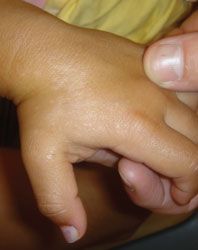Do You Recognize This Skin Condition?
Linear bands of hypopigmentation on a child's hand.

THE CASE: Linear bands of hypopigmentation on a child's hand.
(Answer and discussion on next page.)
Lichen striatus is the correct answer.

DISCUSSION: The diagnosis is lichen striatus, an eruption that usually appears in linear arrays that follow the lines of embryological cleavage (the lines of Blaschko).
Lichen striatus has a variety of clinical appearances, including white, pink, and brown macules and papules. The papules are usually flat-topped, with smooth or scaly surfaces. Rarely, lichen striatus can manifest with vesicles. This condition most commonly affects the arm and thigh; the forehead, hand, shin, trunk, head, neck, and buttocks are less commonly affected. Lichen striatus is usually asymptomatic.
The diagnosis can be made clinically. Lichen striatus can resemble other blaschkoid dermatoses (eg, inflammatory linear verrucous epidermal nevus), segmental vitiligo linear lichen planus, linear porokeratosis, and linear psoriasis. The last 3 entities are not common in childhood. When lichen striatus manifests with vesicles, zoster and incontinentia pigmenti must be considered in the differential diagnosis.
Lichen striatus is self-limited and does not require treatment. If it affects the nails, it can lead to nail destruction. In dark-skinned persons, the disorder may leave behind hypopigmentation when it resolves. If the lichen striatus is associated with xerosis or pruritus, mild topical corticosteroids may be used.
Blog Poll
|
Web Survey
Case and image courtesy of Noah S. Scheinfeld, MD, JD, of Columbia University.
Recognize & Refer: Hemangiomas in pediatrics
July 17th 2019Contemporary Pediatrics sits down exclusively with Sheila Fallon Friedlander, MD, a professor dermatology and pediatrics, to discuss the one key condition for which she believes community pediatricians should be especially aware-hemangiomas.